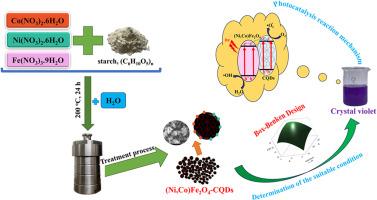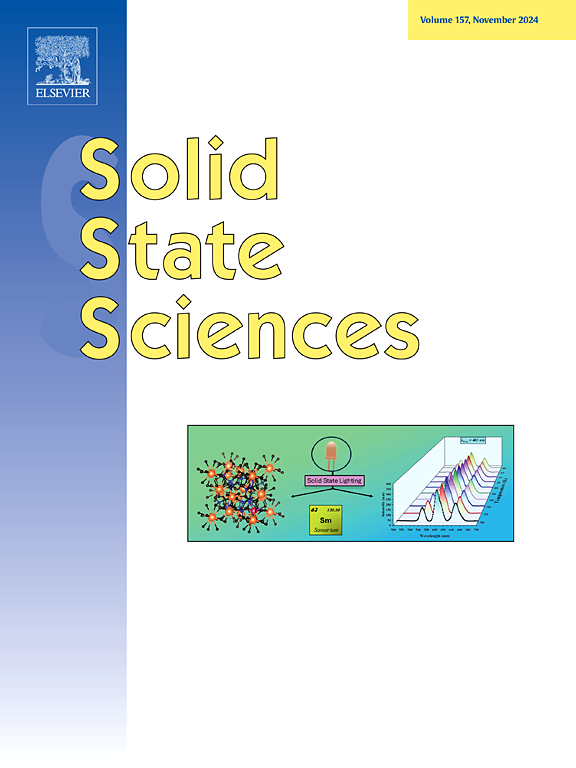Visible light-driven photocatalytic performance of (Ni, Co)Fe2O4-carbon quantum dots nanocomposites: Synthesis and optimization via Box–Behnken design
IF 3.3
3区 化学
Q2 CHEMISTRY, INORGANIC & NUCLEAR
引用次数: 0
Abstract
A series of spinel-type NixCo1-xFe2O4-carbon quantum dots (CQDs) nanocomposites were synthesized via a one-pot hydrothermal method, utilizing inorganic precursors and starch as a green carbon source. The obtained nanocomposites exhibited uniform particle sizes (∼9 nm), a narrow bandgap (∼2.2 eV), and superparamagnetic behavior (saturation magnetization ∼7.6 emu/g; coercivity ∼11 Oe), which facilitated magnetic separation. Their photocatalytic activity was evaluated by the degradation of crystal violet (CV) under simulated solar irradiation, resulting in a removal efficiency of up to 94.7 %. The process parameters, including dye concentration, catalyst mass, and irradiation time, were optimized using the response surface methodology (RSM) based on the Box–Behnken design (BBD). The optimal conditions were determined to be a CV concentration of 7.4 mg/L, a catalyst mass of 51.0 mg, and an irradiation time of 157 min, with the model showing excellent agreement between experimental and predicted values (R2 = 0.995; R2a = 0.987; R2pred = 0.937). These results suggest that NixCo1-xFe2O4-CQDs nanocomposites are promising candidates for efficient, magnetically recoverable photocatalysts for environmental remediation applications.

(Ni, Co) fe2o4 -碳量子点纳米复合材料的可见光驱动光催化性能:Box-Behnken设计合成与优化
以无机前驱体和淀粉为绿色碳源,采用一锅水热法制备了尖晶石型nixco1 - xfe2o4 -碳量子点(CQDs)纳米复合材料。所得纳米复合材料具有均匀粒径(~ 9 nm)、窄带隙(~ 2.2 eV)和超顺磁性(饱和磁化强度~ 7.6 emu/g;矫顽力~ 11 Oe),有利于磁分离。通过模拟太阳辐照对结晶紫(CV)的降解,评价了它们的光催化活性,去除率高达94.7%。采用基于Box-Behnken设计(BBD)的响应面法(RSM)对染料浓度、催化剂质量、辐照时间等工艺参数进行优化。优化条件为CV浓度为7.4 mg/L,催化剂质量为51.0 mg,辐照时间为157 min,模型与实验值吻合良好(R2 = 0.995;R2a = 0.987;R2pred = 0.937)。这些结果表明,NixCo1-xFe2O4-CQDs纳米复合材料是一种高效的、磁可回收的光催化剂,可用于环境修复。
本文章由计算机程序翻译,如有差异,请以英文原文为准。
求助全文
约1分钟内获得全文
求助全文
来源期刊

Solid State Sciences
化学-无机化学与核化学
CiteScore
6.60
自引率
2.90%
发文量
214
审稿时长
27 days
期刊介绍:
Solid State Sciences is the journal for researchers from the broad solid state chemistry and physics community. It publishes key articles on all aspects of solid state synthesis, structure-property relationships, theory and functionalities, in relation with experiments.
Key topics for stand-alone papers and special issues:
-Novel ways of synthesis, inorganic functional materials, including porous and glassy materials, hybrid organic-inorganic compounds and nanomaterials
-Physical properties, emphasizing but not limited to the electrical, magnetical and optical features
-Materials related to information technology and energy and environmental sciences.
The journal publishes feature articles from experts in the field upon invitation.
Solid State Sciences - your gateway to energy-related materials.
 求助内容:
求助内容: 应助结果提醒方式:
应助结果提醒方式:


